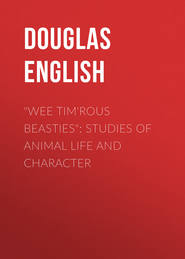По всем вопросам обращайтесь на: info@litportal.ru
(©) 2003-2024.
✖
A Book of Nimble Beasts
Настройки чтения
Размер шрифта
Высота строк
Поля
"Don't rush!" the Pygmy screamed behind. "Don't rush! It's death to rush!"
And yet it was his rush that saved him.
"Don't rush!" the Pygmy screamed behind
The crumbled earth which still lay in the bolt-hole, melted before it. Part slipped to either side of him. Part massed before his plunging head, and, reaching the clear downshaft, dropped. With it there dropped a stone—a rounded half-inch stone, which danced along the gallery at the foot, cannoned from side to side of it, spun round and pulled up short, six inches in advance of him. His senses signalled something in his path. His senses signalled a clear passage through it, and a clear space beyond it. His senses urged more pace. So he crashed on. He stubbed his hands against a ring of iron: the ring gave way: there was a snap and two iron jaws had gripped his waist. But for the stone which jammed against the clinch of them, he must have met his death. And death itself had scarcely brought more torture. It was as though the half of him sped on while half remained behind. The back wrench left him senseless, and so the Pygmy found him. It was the pit-pat of her on his fur, the cobweb flutter of her questionings, which roused him back to life.
His Fortress, his own Fortress, had been breached
"I'm done," he muttered, "done as sure as sure."
"Not you!" she answered bravely, "the trap's not closed—not half. Wriggle, dear Uncle, wriggle!"
And Bartimæus wriggled.
He wriggled right; he wriggled left; he wriggled up; he wriggled down; he brought his hands to bear upon the iron and with a supreme twist he wriggled free.
Then he saw red.
He flung himself against the trap, and bit at it, and scratched at it, and shook it with his shoulders, and heaved and strained and wrenched at it, until it lay upturned upon the surface. He was convulsed with windy gusts of rage: nose-tip to tail he boiled; nor did he gain composure until the field was far behind, and he had reached the smooth-faced tube which led to his own fortress. Hand over foot he sped the length of it, dived down the U-shaped entrance hole, bobbed up again and climbed into his nest.
His troubles were not over.
His fortress, his own fortress, had been breached. The nest lay open to the day, windswept.
For a full hour he toiled repairing it, then, mole-tired, coiled to sleep.
SOMETHING ABOUT A CHAMÆLEON
(NOVEMBER)
"''Tis green! 'tis green, Sir, I assure ye.'
'Green!' cries the other in a fury.
'Why, Sir, d'ye think I've lost my eyes?'
''Twere no great loss,' the friend replies,
'For if they always serve you thus,
'You'll find them but of little use.'"
I WONDER how many of you know these lines? Not so very long ago most young people used to have to learn the poem from which they are taken, but I don't think the poem can be quite such a favourite as it used to be. Perhaps we are all getting to be such good naturalists that we know it is not quite true, for, though Chamæleons change their colours in a very wonderful way, they do not go red, white, and blue, in the way which the poem makes out.
I think I must tell you a little story about a Chamæleon, though some of you may perhaps have heard it before. An old lady once had a pet Chamæleon which she was very fond of, and which her manservant, John, used to look after. He was very fond of the Chamæleon too, and he used to amuse himself by putting it on to different coloured things in his room and watching it change colour. Well, one day, the old lady had a friend to tea, and she thought she would like to show her the Chamæleon, so she rang for John.
"John," she said, "bring in the Chamæleon."
John looked very sorry for himself. "Please ma'am," he said, "I can't."
"Can't?" said his mistress. "Why not?"
John looked still more confused. "Please, ma'am," he said, "he's gone."
"Why, how is that?" said the lady.
"Well, ma'am, I was playing with him, and I put him against my baize apron, and he turned green."
"Well?"
"And then I put him against the red tray, ma'am, and he turned red."
"Yes, yes! Of course he would."
"And then I put him against your tartan plaid, ma'am, and—and he just bust hisself."
You can see his Eye looking back over his Shoulder in this Picture
I am afraid that that story is not altogether true either.
I must try to explain to you how a Chamæleon changes colour. Of course you all know that there are black men, and brown men, and copper-coloured men, and yellow men, and what we call white men; and you know, too, that among white men some have much darker skins than others.
Now the colour of people depends a little on the colour of their blood, for there is a network of tiny veins in the lower part of their skin, but it depends even more on millions of little specks of yellowish and brownish paint which lie in the upper part of their skin. A negro may be as black as your hat outside, but his blood is red all the same, and he looks black because the little specks of paint in the upper part of his skin are very dark and hide the red blood behind them. When people change colour it is because for one cause or another the colour of their blood can be more plainly, or less plainly, seen; and, when this cause is taken away, their old colour returns, for the little specks of paint have not altered in themselves at all.
You can see his Hands and Feet well in this Picture
In Chamæleons, however, and several other creatures, which change colour much more than we do, and keep their changed colour for quite a long time, the specks of paint lie in the lower part of the skin, and often there are numbers of them clustered together as if they had been pressed down tight into little bags. These clusters of paint specks have the power of branching out like sea anemones, and afterwards pulling themselves together again like sea anemones when they are frightened. When they are spread out so as to be as large as possible, the Chamæleon is dark-coloured; and when they are drawn in so as to be as small as possible, the Chamæleon is light coloured; and when, as is really most usual, they are spread out in one part of his body and drawn in in another, the Chamæleon is piebald. I expect you will be curious to know what colour the specks of paint are, and whether they are always the same. They are so small that one needs a powerful microscope to see them; but, as far as we can tell, they are always brownish or reddish, so that the greens and blues which are often to be seen in patches on a Chamæleon have to be accounted for in some other way. It would take too long to explain the blues and greens to you thoroughly, but I think I can give you one little hint about them. You all know what mother-of-pearl looks like. If you hold a piece one way it seems a dull grey all over, but if you hold it another you see all the colours of the rainbow, and you can even make the colours move about it if you handle it properly. Now if the colours were paint they would not move about, though they might not be so bright in some positions as in others, and for the present you must be satisfied to know that a Chamæleon skin, besides holding clusters of paint-specks which change their shape, is so wonderfully made that it can show mother-of-pearl colours as well.
A grown-up Chamæleon is usually greenish in the daytime, with brown patches on his sides. When he goes to sleep at night he turns cream-coloured and his patches become yellowish. A baby Chamæleon is snowy white, and doesn't get spotted even when he is angry or excited, as a grown-up Chamæleon always does.
Now for the Chamæleon pictures. First you must notice his eyes. He has enormous eyeballs, but instead of having two eyelids to each, as we have, he has one eyelid to each (it is really made up of two stuck together), with a tiny round hole in the centre for his eye to look through. This is queer enough, but there is something even queerer about a Chamæleon's eyes. He can move either eyeball up or down or sideways, but he hardly ever moves both the same way, so that he has quite the most wonderful squint in the world, and often keeps one eye looking over his shoulder while the other looks straight in front of him.
Next you must look at his long, skinny arms and legs, and especially at his hands and feet. Like ourselves he has five fingers or toes on each, but they are differently arranged from ours. You must remember, of course, that our thumbs are really fingers. On each hand a Chamæleon has three thumbs and two fingers, and on each foot he has two great toes and three ordinary toes.
THE TRAIL OF NIMBLE BEASTS
(DECEMBER)
Top Row Nuts gnawed by Meadow Mice
Second Row " Dormice
Third Row " Field Mice
I AM going to end the articles in this book by telling you how you may best see for yourselves some of the queer creatures which I have photographed, for the real beasties are far, far more interesting than any photographs of them can be, and they are not so very difficult to see if only you go the right way about it. I think the Winter is as good a season as any to begin in, at any rate with the fur-folk, for there is sure to be plenty of mud, which is a splendid thing for footprints to show up on, and there may be a fall of snow, which will tell you more in a day of the coming and goings of your little brothers, than you could learn without it in a year.
If you put on your thickest boots and go out into the fields and along the hedgerows, after a heavy snowfall, you will find thousands and thousands of footprints. Most of these will be the footprints of birds, but some, you will see at once, belong to four-footed creatures. I am showing you pictures of some of the commonest of these so that you may know them the next time you see them. I have left out Bunny-Rabbit on purpose, because I think you will be able to find out what his curious footprints are like for yourselves, and will remember them better that way.
The Weasel's Trail
We will begin with the Weasel's trail in the picture on the opposite page. You will see that there are two different looking trails showing, but they both belong to the same weasel. The reason they look so different is that one set are fresh and the other set are a day old. There has been a slight thaw, and this has melted the snow so that the oldest trail has fallen in a little. All the trails lead to a woodpile, and I used, after the snow had all gone, to go to that woodpile in the evening and wait for the weasel to come out, and watch him play, which he always did for some time before he started hunting.






